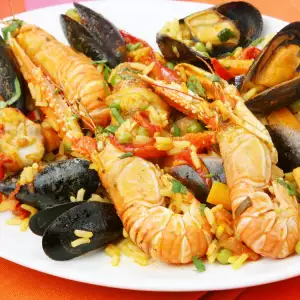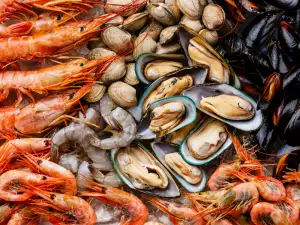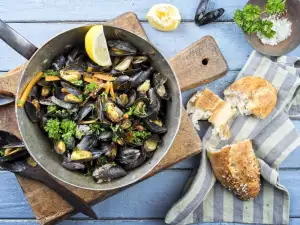Seafood and its flavor of sea breeze is often associated with the pleasant emotions of summer. The good news is that we can find fresh or frozen seafood year-round commercially, but, of course, just caught and cooked mussels, calamari and lobster with a little lemon flavor are second to none in terms of aroma and taste.
We can divide the whole range of seafood we use for food, into two large groups - molluscs and crustaceans. The molluscs entry includes oysters, mussels, squid, octopus. For some it is typical that they feed by filtering water. The group of crustaceans presents all kinds of crabs, lobster, shrimp, etc.
Besides being incredibly delicious, they are considered delicacies and seafood is very useful and nutritious food. Suffice it to say that the Japanese are the nation with the highest life expectancy, and their menu is based mostly on seafood, rice and soybeans. Japanese women eat an average of 50 times more fish, 17 times more rice and three times more soya than European women.
On top of that seafood is considered a dietary product. Thanks to seafood, the Japanese diet is about 2 times lower in calories than our diet. Recently researchers have even discovered the remains of shells in a cave in southern Spain, which confirmed that Neanderthals, like Homo Sapiens, hunted and survived on seafood 150 000 years ago.
Types of seafood
Scallops - these are second in production after the oysters. They include about 25 000 species distributed in rivers, seas and oceans, particularly in the coastal area. Most popular and consumed is black mussel (Mytilus edulis). Popular is also white clam (Mya arenaria), and among the largest global delicacies are the famous scallops (Pecten maximus).

Crabs - These crustaceans are available year-round - fresh and frozen. The living crabs need to boil first and then you can take the meat out, and if they are frozen, you can directly proceed to separate the meat. A crab weighing 900 g is able to provide around 300 g of meat. The shell of boiled crab changes color and becomes orange, then another 8 minutes extra for each 500 g weight.
Oysters - first in the world in production. Before you eat oysters, they must be brushed very well, washed, opened with a sharp knife and the meat is washed. Oysters are delicious raw, served in a shell with a little lemon juice. They are considered a delicacy, and have long had a reputation as an aphrodisiac.
Shrimp - seafood that has more than 2000 species. The largest individuals are of the Dublin Bay (Langustini) kind. After them come "jumbo and tiger prawns. When cooking them fresh, you should take the head shell and vein in the back. This seafood is also tasty prepared very simply, steamed with a little oil, garlic and white wine.

Lobster - is considered the largest crustacean. There are about 163 known types of lobster distributed worldwide. They prefer colder water and in Canada was found the largest specimen - weighing 20 - 14 kg, aged more than 100 years. Lobsters on the market are around the age of 10 years. Always choose a larger lobster, ensuring you get more delicious meat.
Squid - seafood that are predators, and have more than 300 species. For the most part, they inhabit tropical seas. They have delicious and nutritious meat, which is actually their body and tentacles.

Octopus - these sea creatures a the test of the culinary skills of an inexperienced cook, but once prepared, octopus is an amazing and tasty type of seafood. Above all, it is boiled, and from then on, it can be baked, fried, etc. Washing octopus is important to remove the ink sac fluid and tenderize well with a wooden mallet.
Sepia – it has about 30 modern types who love the warm waters of very salty seas. They expressed soft and delicious cooking meat. Marinate, then fry them, boil or use in various dishes.
Composition of seafood
Seafood is an invaluable source of many nutrients, vitamins and minerals. They contain almost as much protein as meat, with the difference that they are low calorie. All seafood contains powerful antioxidants, very valuable amino acids that are easily and quickly digestible.
All necessary amino acids for the human body in this type of seafood are absorbed much faster than the meat. Squid, mussels, crabs and other shellfish and crustaceans contain very little fat.
They are all a very important source of essential omega-3 and omega-6 fatty acids is important for the overall good condition of our body.

In almost all the seafood we can find high levels of vitamins - A, D, E, and all the group C. Among the minerals most important is the amount of calcium and iodine in all of them, while phosphorus and iron are in larger doses in crabs, potassium - in squid cobalt - in lobsters, mussels and crawfish.
Lobster meat is rich in zinc, phosphorus, vitamin B12 and copper, and 100 grams of it has 21 grams of protein and only 0, 6% fat. Squid contains many amino acids, vitamins PP and B6 and minerals iron and iodine. In 100 g of whole crab has 221 mg of calcium, while 100 grams of shrimp level is 135 mg. When sardines with bones, calcium is 350 mg, and mackerel are a source of calcium to 3000 mg 100 g
Selecting and storing seafood
When selecting and storing seafood should be extra careful because they are perishable products that spoil quickly and can cause poisoning. Valid for choice of all seafood to choose fresh, preferably live aquatic life. Always try to scent is refreshing marine note, not loud and heavy. Do not buy seafood for their origin and quality of a doubt.
In the presence of an unpleasant smell or abnormal bulging body, it means that shellfish are inedible. Keep in mind that most of the coastal areas, especially lagoons, are already heavily polluted, which requires that you quite thoroughly clean the seafood before attempting culinary use.
If you buy seafood from a large food chain, it should have a guarantee of quality. You always have the option to select frozen seafood that is found in refrigerated coolers and freezers. However, watch the expiry date on the package.
Culinary uses of seafood
Seafood is known that for the most part, it is made very quickly and easily, simply by adding some spices taste their and is a delicacy.
Suffice it to boil, fry or steam the seafood, spice it to taste and add lemon extract, garlic and parsley, for example. Cooking shrimp, lobster and other sea delights is done by steaming them, as they are very tender and the meat retains all nutrients.

A quirk in the preparation of these, commands that you may dull the heavier flavor of the sea and seabed, if you add 2-3 tablespoons vodka or white wine with cooking.
Remember that squid should not be cooked above 80 degrees temperature. It is enough just to leave it in hot water for 5-6 minutes. If you do cook squid, it is best to first is marinate it in soya and lemon juice after you have previously cleaned its bone, belly and back.
In serving and consumption of seafood, perhaps only certain types of crabs can cause slight difficulty. If you are having a crab, it is better to use the special clip and triangular small fork, which must come in any such presentation.
Benefits of seafood
A balanced diet including seafood, will make you feel full, satisfied and inspired for new challenges. All this is due to a cocktail of vitamins, minerals and amino acids that are important for the body. In particular, the high content of iodine in seafood ensures best use of the thyroid gland.
Phosphorus in the shells regulates energy metabolism of the cells, which is fundamental to the entire physiological process. Zinc in shellfish seafood helps the skin to not dehydrate in the summer heat.
All seafood is a source of powerful antioxidants that protect against acute and chronic lung diseases. Additionally, the nutrients in this type of food are good for the immune system and protect you against viral diseases.
Studies show that seafood reduce the risk of Alzheimer's disease. Zinc is crab and squid and rich content of vitamin B12 is important for hematopoiesis and maintenance of the nervous system. Vitamin B2 is abound in octopuses and supports our vision.
Seafood can help us lose weight because they are low-calorie. While being sufficiently rich in protein, vitamins and minerals, which ensures that you will not have shortage of important nutrients. The phosphorus, sodium, vitamin B1 in seafood are those that save us from the accumulation of excess pounds. Without these carbohydrates in the body can be converted into energy, and fat.

Dangers of seafood
Although delicious, seafood is often poisonous food. Because they are perishable, they can often cause poisoning. Pollution of the seas and oceans, and the fact that some seafood feeds by filtering water is also reason for caution when selecting, cleaning and preparing it. It is important to know that there are a large number of microorganisms involved in the composition of the microflora of seafood.
Signs that you may have eaten low quality seafood are numbness of the tongue and lips, a few hours after the consumption of seafood, metallic taste during consumption, stabbing abdominal pain, abnormal temperature sensitivity. All these are signs of food poisoning.
By filtering water, some seafood accumulate inside organisms that cause hepatitis A and E, Norwalk - viruses, infections with E. coli, Salmonella typhi, Shigella, Vibrio, Aeromonas and Plesiomonas. Particularly sensitive in this respect are the oysters. Fishing experts in bay 36 of the United States reported a large presence of salmonella.




















Comments